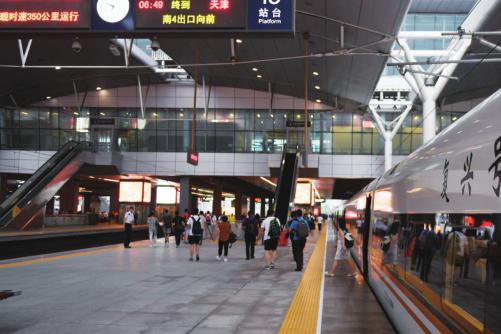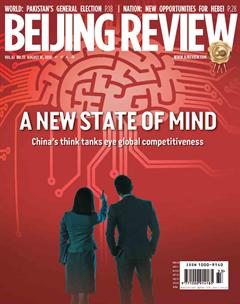Sweet Harvest

A villager harvests grapes in Xiangmo Village in east Chinas Shandong Province on August 7, which was liqiu, the beginning of autumn this year according to the Chinese solar term.
Biosafety Lab
On August 7, China put into operation a high-level biosafety lab in Harbin, capital of northeast Chinas Heilongjiang Province.
The fi rst biosafety level-4 lab (BSL-4) for large animals was accredited by the China National Accreditation Service for Conformity Assessment, with BSL-4 being the highest biosafety level.
The national animal disease control lab could boost the countrys research on and prevention and control of highly infectious diseases, according to the Harbin Veterinary Research Institute under the Chinese Academy of Agricultural Sciences, the labs operator.
It will conduct animal testing on pathogens of all known major infectious diseases, the institute said.
The lab will also work with other institutes on joint research of the prevention and control of highly infectious diseases in a bid to safeguard the livestock industry and public health, it said.
Breastfeeding Support
Chinese experts called for support from society to create an environment for breastfeeding during World Breastfeeding Week which ended on August 7.
“Breastfeeding is crucial to childrens healthy growth and the health of the whole nation,” Lu Mai, Secretary General of the China Development Research Foundation, said at a forum on breastfeeding.
The rate of breastfeeding in China is lower than 50 percent among six-month-old infants, according to the World Health Organization.
Liu Li, a young mother, said she never received any guidance or services for breastfeeding during the sixweek postpartum recovery period.
“Mothers need support from both family and social communities for breastfeeding, including medical care institutions and work places, and they also need legal protection and social security,” said Ge Yanfeng with the Development Research Center of the State Council.
Ges view was echoed by a report released by the China Development Research Foundation. “Measures should be taken to raise public awareness of the importance of breastfeeding, encourage medical care institutions to provide professional guidance and help for new mothers, and improve legislation for maternity leave and the childbirth insurance system,” the report said.
Counting Court Cases
Courts across China accepted nearly 12.3 million new cases in the fi rst half of the year, according to the Supreme Peoples Court (SPC).
By June 30, the country had 124,000 judges who had each accepted about 100 cases on average since the beginning of the year. The number of cases accepted per judge in Beijing and Chongqing municipalities and Zhejiang Province averaged more than 150.
Courts nationwide concluded 9.53 million cases in the fi rst six months, up 4.41 percent year on year, with each judge handling 76.8 cases.
The six circuit courts of the SPC in Shenzhen, Shenyang, Nanjing, Zhengzhou, Chongqing and Xian accepted 7,873 new cases in the six months, accounting for 68.5 percent of new SPC cases.
During the same period, the circuit courts closed 6,140 cases, 69 percent of the cases closed by the SPC.
By July 31, courts across the country made public more than 49.46 million judgment documents on China Judgments Online, Chinas court document website, drawing more than 18 billion views.
The website for live streaming trials showed more than 1.22 million trials, receiving 8.3 billion views.
Internet Fraud
A report on Internet privacy and fraud warned the public to stay vigilant about Internet security risks, including phone scams, fraud messages and malicious websites.
Technology giant Tencent detected 96.8 million malicious websites, tagged 29.7 million phone numbers used for fraud, and blocked 18.3 million fraudulent messages in the fi rst six months of this year, according to the report jointly released by the Tencent Research Center and the Data Center of China Internet.
The most common fraudulent messages included those on illegal loans, virus software, malicious websites, fake job positions offering high salaries and online shopping.
The report warned the public of the risks, saying that people should always stay alert and remain sober-minded.
It also pointed out that 56.9 percent of malicious websites were pornography sites, while 34.4 percent were gambling sites.
The report said the big proportion of gambling sites in the fi rst half of the year was due to the 2018 FIFA World Cup held in Russia this summer.
Water Diversion Project
The fi rst phase of the middle route of the South-to-North Water Diversion Project delivered more than 865 million cubic meters of water to 30 rivers in the north, according to the Ministry of Water Resources.
The project channeled water from the Danjiangkou Reservoir to the 30 rivers in Tianjin Municipality as well as Hebei and Henan provinces, between April 13 and the end of June.
Chen Mingzhong, head of the water resources department at the ministry, said that wetlands and lakes along the route received water in greater volume and of better quality, and that underground water pressure had been eased.
The Baohe Reservoir, for example, upstream of Baiyangdian Lake in Hebei, was dried up for 36 years but now has abundant water thanks to the project.
The south-to-north water diversion scheme, the worlds largest, takes water from the Yangtze River to feed dry areas in the north through eastern, middle and western routes.
The fi rst phase of the middle route begins at Danjiangkou in Hubei and runs through Henan and Hebei before reaching Beijing and Tianjin.
Since December 2014, the route has transferred more than 15 billion cubic meters of water to Chinas northern regions.
Horseback Celebrations
Herdsmen prepare to perform and race on horseback in Rima Village in Gerze County in southwest Chinas Tibet Autonomous Region on August 6. The event is a celebration that takes place after the harvesting of cashmere.
Vacation Fun
Children learn about 3D printing at a community center in Yuquan District in Hohhot, north Chinas Inner Mongolia Autonomous Region, on August 7. A community in Hohhot organized free activities for children to learn about new technologies during their summer vacation.
Medical Sector Supervision
The Chinese Government has ordered the strengthening of supervision over the medical sector to better protect the health of the public.
A guideline issued by the State Council, released on August 3, said the scope of supervision should be expanded from medical institutions to the entire medical and health sector. Supervision should cover all areas, using all sorts of measures, including administrative, legal and economic ones, it said.
The guideline stressed that bodies should be identifi ed to enforce supervision with clearly-defi ned duties and powers.
The reform of administrative approval should be sped up, supervision over the quality of medical services strengthened, the operation of medical institutions monitored, and medical personnel scrutinized, it said.
A credit system for the entire medical sector should be set up and information needs to be made public on a regular basis. A system to detect and analyze risks should also be set up, using information technology to forestall major risks. The guideline emphasized accountability to enforce order to establish an authoritative and effective supervision system.
Traffic Public Services
The Traffi c Management Bureau(TMB) with Chinas Ministry of Public Security (MPS) announced that traffi c public services will be streamlined nationwide starting in September.
Twenty measures will be introduced, including requiring fewer or zero application materials, enabling citizens to handle different matters at the same counter, and providing access to public services online. This is all part of a campaign to improve public services in the area of traffi c.
The MPS released the 20 measures in June and piloted eight of them in 36 major cities.
In a teleconference convened on August 2, the TMB asked its subordinate organs to work hard and get ready for implementing the reform measures nationwide.
China had 319 million motor vehicles and 396 million licensed vehicle drivers as of the end of June, according to MPS data.
China Hits Back
China will impose a 25-percent tariff on $16 billion worth of goods imported from the United States on August 23, the latest countermeasure to defend its legitimate interests and the multilateral trading system, the Ministry of Commerce announced on August 8.
The latest U.S. move has unreasonably put its domestic law above international law again, the ministry said in a statement. China will implement its tariff simultaneously with the U.S. measure, the statement said.
China will impose the tariff on 333 categories of U.S. products including vehicle engines, vans, cars, trucks and chemicals, according to an announcement and an attached list issued by the Customs Tariff Commission of the State Council on August 8.
The declarations came after the Offi ce of the U.S. Trade Representative announced on August 7 that it would collect the 25-percent tariff on an additional$16 billion worth of Chinese imports starting on August 23.
The U.S. trade representatives offi ce released a fi nal tariff list targeting 279 product categories from China. Only fi ve products, including fl oating docks, were omitted from what the offi ce initially proposed on June 15.
The majority of the $16 billion worth of Chinese products subject to U.S. tariffs are semiconductors and related products. Many of them are designed and manufactured in the United States, then shipped to China for testing and packaging.
According to the list released by the U.S. trade representatives offi ce, other sectors that are subject to higher additional tariffs include circuit components for remote controls and vending machines, resistors and capacitors.
The United States already imposed a 25-percent tariff on $34 billion in Chinese goods in July and China responded in kind.
Power Transmission
Electric cables are installed at a wind power base in north Chinas Shaanxi Province on August 7.
The 750-kilovolt electricity transmission project is the largest of its kind in the province, with the total investment reaching 5.03 billion yuan ($737.5 million).
Foreign Trade
Chinas goods trade went up 8.6 percent year on year to 16.72 trillion yuan ($2.45 trillion) in the fi rst seven months of this year, customs data showed on August 8.
Exports rose 5 percent year on year in the January-July period while imports grew 12.9 percent, resulting in a trade surplus of 1.06 trillion yuan ($155.1 billion), which narrowed by 30.6 percent, according to the General Administration of Customs.
In July, exports rose by 6 percent to 1.39 trillion yuan ($203.4 billion), while imports jumped 20.9 percent to 1.21 trillion yuan ($177.1 billion).
In the fi rst seven months, exports and imports of products under the general trade category, which are differentiated from processing trade, climbed 12.7 percent from a year ago to 9.85 trillion yuan ($1.44 billion), accounting for 58.9 percent of the total foreign trade, 2.1 percentage points higher than the same period in 2017.
The countrys trade with major trading partners saw an increase during the January-July period. Trade with the European Union, its largest trading partner, climbed 5.9 percent, and trade volume with the United States and ASEAN countries increased by 5.2 percent and 11.6 percent, respectively.
Trade with countries along the Belt and Road totaled 4.57 trillion yuan ($668.7 billion), up 11.3 percent year on year, 2.7 percentage points faster than the average growth rate, data showed.
Forex Management
Chinas foreign exchange regulator said on August 2 that it will continue to reform its forex management in the latter half of 2018.
The country will make the yuan convertible under the capital account in an orderly manner, and protect the interests of foreign investors, according to a statement from the State Administration of Foreign Exchange.
In the latter half of the year, efforts will be made to enrich forex products and instruments, and expand the market access of both domestic and overseas participants to build an open and competitive forex market.
The administration added that it will continue to make trade and investment more convenient, ensure forex management and services for the fi rst China International Import Expo in November, and seek steady progress in forex management pilot programs in free trade zones and ports.
China should also prevent and defuse major risks related to foreign exchange, take a fi rm stance against fake transactions, illegal bankstyle organizations, and illicit forex transaction platforms.
The country must ensure the safety and liquidity of foreign exchange reserves to maintain and increase their value, the statement said.
Smartphone Giant
Chinese smartphone maker Huawei has surpassed Apple to become the worlds second-largest smartphone seller, a market research fi rm said.
Huawei shipped around 54.2 million handsets in the second quarter, showcasing a 40.9 percent year-on-year growth and a 15-per- cent global market share, while Apple shipped approximately 41.3 million units, according to data from the U.S.-based International Data Corporation (IDC).
Huaweis rise is deemed signifi -cant as it is the fi rst time since 2010 that the top two global smartphone vendors have not been Samsung and Apple. Samsung remains the current leader with a 20-percent market share for the second quarter.
Analysts say that Huawei is gaining more brand recognition in Europe and Asia as it has been adding top-end features to its fl agship smartphones. For instance, the companys P20 Pro handset boasts three rear-facing cameras, including one with 40 megapixels.
Singapore-based research fi rm Canalys attributed Huaweis strong overseas performance over the quarter to the success of its P20 and Honor brands. It said Huawei shipped nearly 4 million Honorbranded smartphones outside of China in the quarter, registering a 150-percent year-on-year increase.
Huaweis prominence comes amid a global decline in smartphone demand. IDC fi gures showed that there was a 1.8-percent annual decrease in the smartphone market for the second quarter.
Data from several other research fi rms including Counterpoint Research and IHS Markit also confi rmed Huaweis global No.2 position for the quarter.
Faster than Ever
Passengers alight from the C2003 Beijing-Tianjin bullet train at Tianjin Railway Station on August 8.
That same day, the speed of the intercity railway was elevated to 350 kilometers per hour, with the travel time from Beijing to Tianjin shortened from 35 to 30 minutes.
Third-Party Payment Regulated
Chinas central bank confi scated the illegal gains of and levied fi nes on three companies for violating regulations on payment services, the Peoples Bank of China said on August 6.
The confi scated illegal gains and fi nes totaled 77 million yuan($10.29 million).
Gopay.com had 22.18 million yuan ($3.25 million) in illegal gains confi scated and was fi ned 24.29 million yuan ($3.56 million) after it was found to have failed to carry out effective checks on transactions by online vendors, thus providing online payment services with de facto illegal transactions. It also provided payment services for traders with vague identities.
Union Mobile Financial Technology Co. Ltd. was fi ned 14.32 million yuan ($2.1 million) in addition to the confi scation of 12.08 million yuan ($1.77 million) in illegal gains after it was found to have conducted loose checks on customer identifi cation and engaged in the illegal overseas transfer of foreign exchange.
The Shanghai branch of the central bank issued a fi ne of 4.12 million yuan ($604,061) on Alipay, the third-party payment service offered by Alibaba, for violating payment service regulations.
The central bank has taken a tough stance on Internet fi nance irregularities lately to improve market order. Two other third-party payment companies were fi ned a total of 34.75 million yuan ($5.09 million) at the end of July.
Drifting to Prosperity
Tourists rafting in Daxi Village, Anji County, east Chinas Zhejiang Province, on August 7.
Since 2000, Daxi Village has been developing its eco-tourism industry. In 2017, its service industry revenue hit 230 million yuan ($33.75 million).

